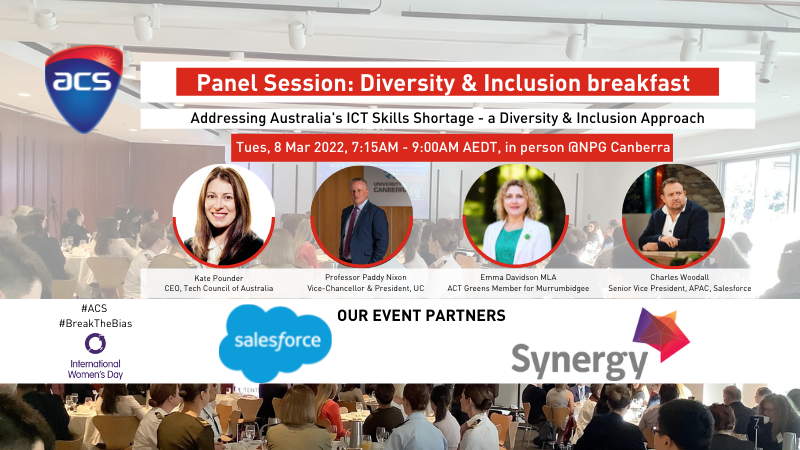
The future technology workforce – how should it look and where should it come from?
2 Feb 2022
As the ACS Canberra Branch Manager, and devoted scientist, I am again starting a new year with the annual question “how can I help influence the diversity of the tech/STEM workforce in a meaningful way?”.
Perhaps there is series of question that should be asked rather than the one above.
What should the tech workforce look like? What different skill sets does it need across the job families?
And then the kicker question…How to we achieve diversity across all job families in the tech workforce?

The 2021 ACS Australia’s Digital Pulse (1) reports that technology employment is forecast to grow by almost 300,000 by 2026. That’s across six occupation groupings and 26 classifications of technology workers at the four-digit ANZSCO level as determined by the Center for Innovative Industry Economic Research Inc (CIIER).
In terms of gender diversity, Digital Pulse reports that women make up 29% of the technology sector. This is not representative of the population, and is less than other professional, scientific and technical services (PST) industry. It is worth noting that the tech occupations with the lowest share of women are ITCT technical and professional (26%) and ICT trades (16%) (2).
Women make up only 19% of university information technology enrolments and 18% of completions. In 2019, that was 1,240 female IT university graduates. The VET completion rate for women has increased to 33% since 2017, but actual numbers of female IT VET graduates has dropped by 230 between 2018 and 2019 as overall VET IT completions has been dropping for the past 5 years.
In 2016, the percentage of qualified Aboriginal and Torres Strait Islander adult population with university qualifications in Information Technology was less than one tenth of non-Indigenous adults and the percentage of overseas born IT qualified people living in Australia was 58.5%.
While details of people with a disability working in the technology sector is not easy to find, the Australian Institute of Health and Welfare report that working-age people with disability have a 32% lower employment rate that those without disability (3).
If the technology sector truly had a diverse workforce, there would not be pockets of occupations and/or skill sets with disparity relative to the population.
There are a number of organisations and programs addressing diversity in the technology sector, which are making a difference. These include supporting women into tech leadership positions, programs to encourage Aboriginal and Torres Strait Islander children to study STEM, and recruitment processes that recognise the needs of people with disability and the strengths of people with non-technology educational backgrounds. Perhaps a sector wide approach to implementing small incremental changes can also help.
On 8 March, ACS Canberra will be hosting a discussion on addressing Australia’s technology skills shortage using a diversity and inclusion mindset.
Our panelists, Minister Emma Davidson (ACT Greens), Professor Paddy Nixon (Vice Chancellor, UC, Kate Pounder (CEO, Tech Council Australia) and Charles Woodall (VP APAC, Salesforce) will be sharing experiences and examples of ways the sector can implement change.
Topics will include addressing the qualification and pipeline gap, retention and workplace culture gaps. Benefits of professionalisation of the technology workforce and how this can also address diversity in the sector will be discussed by our panelists.
Further information on the breakfast panel discussion can be found here.
Event Details:
ACS Panel: Addressing Australia’s Technology Skills Shortage: A Diversity & Inclusion Approach
Venue: National Portrait Gallery, King Edward Terrace, Parkes ACT 2600
Date/Time: 8 March 2022, 7.15 am -9.00 am
Registration: Click here
Sources
(1) ACS Australia’s Digital Pulse Future directions for Australia’s Technology workforce 2021, Deloitte.
(2) STEM Equity Monitor 2020, Department of Industry, Science, Energy and Resources.
(3) People with disability in Australia 2020, Australian Institute of Health and Welfare,
Contact ACS Canberra Branch acs.canb@acs.org.au if you have any questions regarding to the Panel session on 8 March 2022.
